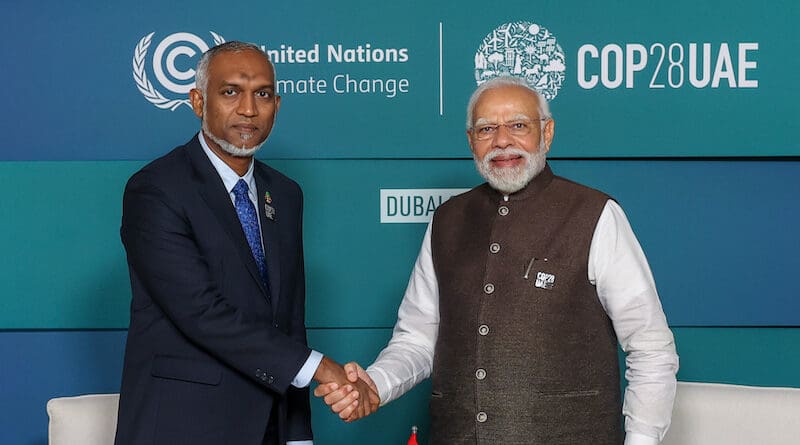P. K. Balachandran

The two governments make contradictory statements after the core group’s meeting in New Delhi on Friday.
In pursuit of its strategic objectives in the Western Indian Ocean, India has adopted a carrot and stick policy towards a recalcitrant Maldives.
The two countries are battling over an Indian military presence in the in the Indian Ocean archipelago.
There are 88 Indian military personnel, with two choppers and a Dornier aircraft, running emergency medical evacuation and search and rescue operations in the Maldivian archipelago.
India wants to retain its military presence here in view of China’s expansionist moves in the Western Indian Ocean. But the Maldivians see the Indian boots on their ground as an affront to their sovereignty.
One the one hand, India is trying to woo the Maldivians by allocating INR 600 crore (US$ 72 million) for the Maldives in its 2024-2025 budget, brushing aside the growing bitterness in the relationship.
But on the other hand, it is wielding a stick by getting one of its Coast Guard vessels to intrude into Maldivian waters, intercept some Maldivian fishing vessels, and interrogate the crew. The Indian action sent the Maldivians into a tizzy. And the government sent a missive to New Delhi seeking an explanation. New Delhi reportedly did not reply.
At the Indo-Maldivian Core Group meeting in New Delhi on Friday, the Maldivians pressed for the withdrawal of the Indian military personnel from the islands by March 15. But India said that it would “replace” the personnel in question beginning on March 10 and ending on May 10.
New Delhi’s statement did not make it clear if “replacement” meant replacement by civilians or by another set of military personnel.
The Maldivian statement on the meeting said: “Both sides agreed that the Government of India will replace the military personnel in one of the three aviation platform(s) by 10 March 2024, and will complete replacing military personnel in the other two platforms by 10 May, 2024.”
To sound accommodative, the Maldivian side stated that the two countries will continue cooperation in the fields of defence and security.
But a statement from the Indian Ministry of External Affairs (MEA) said that the two sides had “agreed on a set of mutually workable solutions to enable continued operation of Indian aviation platforms that provide humanitarian and medevac services to the people of Maldives.”
It is worthwhile noting that while the Maldivian statement specified the date of a partial and a complete withdrawal, the Indian statement made no such commitments.
If the Maldivians expect the Indians to cease operating the aviation platforms, they are mistaken. India has made it clear that the platform will stay with Indian personnel operating them. As to how this can be done is under discussion, the Indians say.
When the Maldivians wanted India to explain the intrusion of its coast guard personnel into Maldivian waters, there was no response from the Indian side.
On the contrary, the Indian External Affairs Ministry spokesman, Randhir Jaiswal, stated that alongside the previously known Chinese vessel, Xiang Yang Hong 03, a second ship, the Lanhai(Blue Ocean), weighing 3,000 tons, was on its way to the Maldives.
India has been wanting the Maldives and also Sri Lanka not to entertain these “spy” vessels in their ports.
While the Sri Lankans said that they had put a moratorium on visits by such vessels, no matter which country they belonged to, the Indians said that they wanted only Chinese vessels to be blocked. The Sri Lankans ignored that plea.
The Maldivians said that they would allow such ships if they came only replenishment and not any kind of under-sea research.
The Indian government has maintained a vigilant stance on developments that could impact its economic and security interests in the region. Indian analysts fear that the data collected by the Chinese vessels could be used to enhance China’s undersea military operations, particularly in anti-submarine warfare capabilities.
The Xiang Yang Hong 03 was scheduled to arrive in the Maldives on 31 January, but maritime tracking information indicates that it is currently lingering just outside the Maldives’ Exclusive Economic Zone. The latest forecast is that it will dock in the Maldives on February 8.
The next meeting of the Indo-Maldivian Core Group is expected to be held sometime at the end of February.
No comments:
Post a Comment